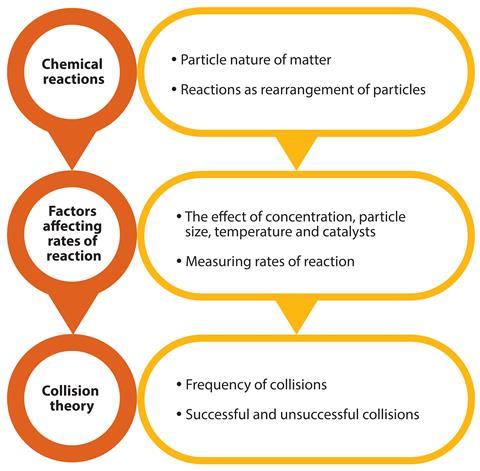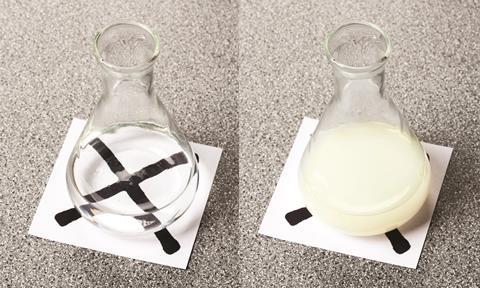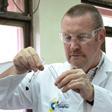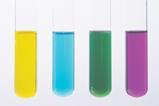David Everett discusses ideas for enhancing practical work on rates of reaction
Why study rates?
The study of reaction kinetics leads to an understanding of a reaction’s mechanism and how we can control the reaction rate. For a 14-year-old student the above question is more likely to be ‘Why are we doing this?’ or ‘What’s it got to do with me?’.
If we are to communicate rates to pupils, they must be engaged with experiments and material that has some relevance to their everyday experiences. I have often wondered how students can ever be engaged with dissolving marble chips in dilute hydrochloric acid. When was the last time, if ever, the average student has come across marble chips in everyday life?
Underpinning chemistry and progression

The study of rates is fundamental to a student’s understanding of chemical reactions. Students encounter the idea that reactions are the result of the rearrangement of particles into new substances and that mass is conserved during a reaction. It is important this concept is fully understood as it leads naturally to an understanding of why altering conditions will alter the reaction rate. At a higher level, students will explain these effects in terms of the frequency of collisions between particles and the energy profile of those particles.
Developing practical skills and progression
Observation skills are at the core of practical work and these skills are developed as students progress through a range of experiments. Some of the difficulties encountered in making observations were discussed in an earlier article (rsc.li/2gMEM7v). In rate experiments, students need to make a judgement about the ‘end point’ when timing a reaction. In some cases this is sharp and obvious. However, in the reaction between sodium thiosulfate and acid, students must judge when the mixture becomes opaque. Students need to practice through a range of experiments if they are to develop this skill.
Observation skills are at the core of practical work and these skills are developed as students progress through a range of experiments. Some of the difficulties encountered in making observations were discussed in an earlier article. In rate experiments, students need to make a judgement about the ‘end point’ when timing a reaction. In some cases this is sharp and obvious. However, in the reaction between sodium thiosulfate and acid, students must judge when the mixture becomes opaque. Students need to practice through a range of experiments if they are to develop this skill.
Measuring skills are central to rate experiments. Collecting gases is particularly problematic – many students find inverting measuring cylinders hard without inadvertently introducing air or fail to collect all the gas generated in the experiment. Again their manipulative skills can only be developed by practising a range of experiments.
Timing reactions is an area where students need to make sophisticated judgements, not only about when the end point of the reaction is reached, but also about the precision of their measurements. The use of digital stopclocks, apparently measuring to milliseconds, is at odds with their ability to stop the device. An analogue stopclock may reduce the likelihood of students recording unrealistic divisions of seconds, but pupils need to develop their judgement about how precisely times are recorded.
Once students have recorded data from experiments, they need to analyse it and translate it into a form that can be readily understood. Drawing appropriate graphs and using them to find a pattern of behaviour is the goal. However, students need help to develop this skill. They may need to be told which axes are appropriate until they can identify the independent and dependent variables. In many reactions students will need to find the gradient of a graph and interpret this in terms of the rate of the reaction. This was discussed in some detail in an earlier article (rsc.li/2D8sIqI).
Once students have recorded data from experiments, they need to analyse it and translate it into a form that can be readily understood. Drawing appropriate graphs and using them to find a pattern of behaviour is the goal. However, students need help to develop this skill. They may need to be told which axes are appropriate until they can identify the independent and dependent variables. In many reactions students will need to find the gradient of a graph and interpret this in terms of the rate of the reaction. This was discussed in some detail in an earlier article.
|
Specification |
|
|
AQA GCSE Chemistry (8462) |
Required practical activity 5 Investigate how changes in concentration affect the rates of reactions by a method involving measuring the volume of a gas produced and a method involving a change in colour or turbidity. This should be an investigation involving developing a hypothesis. |
|
Edexcel GCSE (9–1) Chemistry |
Core practical 7.1 Investigate the effects of changing the conditions of a reaction on the rates of chemical reactions by: a) measuring the production of a gas (in the reaction between hydrochloric acid and marble chips) b) observing a colour change (in the reaction between sodium thiosulfate and hydrochloric acid) |
|
OCR GCSE (9–1) Gateway Chemistry A and OCR GCSE (9–1) Twenty First Century Science Chemistry B |
Practical activity group (PAG) 8 Making and recording of appropriate observations during chemical reactions including changes in temperature and the measurement of rates of reaction by a variety of methods such as production of gas and colour change. |
|
WJEC Eduqas GCSE (9–1) Chemistry |
Specified practical work 9 Investigation into the effect of one factor on the rate of reaction using a gas collection method. Investigation into the effect of one factor on the rate of reaction between dilute hydrochloric acid and sodium thiosulfate. Investigation into the effect of various catalysts on the decomposition of hydrogen peroxide. |
You can reinforce students’ ideas about rates and reactions by including a wide range of relevant practical work, demonstrations and activities into their studies, not just to satisfy the requirements of examination boards. There are many experiments you can use and some of these were discussed in an earlier article (rsc.li/2D8sIqI). Conservation of mass can be investigated in a spectacular precipitation of lead iodide reaction to reinforce the idea that reactions involve the rearrangement of particles (rsc.li/2FG0rtt). A simple experiment using the ethanedioate (oxalate) in rhubarb stems to decolourise acidified permanganate and to investigate the effect of surface area (rsc.li/2EKK3qc) seems more approachable and relevant to students than marble chips dissolving in acid.
Students’ understanding of a topic will improve if the approach is varied and this can be achieved by developing a series of experiments. For instance, there are a number of experiments involving the production of gases. You can use these to help students understand the effect of concentration on the rate of reaction. These experiments also develop their mathematical skills in processing results or developing an investigative approach to a problem. An experiment on the reaction between magnesium and acid uses simple laboratory apparatus (rsc.li/2DzGrId), while an activity on solving an industrial problem can put these ideas into a realistic context (rsc.li/2B7qINW).
Students are fascinated by sudden changes in a reaction. For this reason, variations on the iodine clock reaction can engage students. You can show this as a demonstration (rsc.li/2B4Y67N) or challenge your students to produce a mixture that will suddenly change colour after a defined time (rsc.li/2my8ShE). This practical activity can harness students’ natural competitiveness, engage them in applying their ideas and develop their investigative and laboratory skills.
There are many experiments on the effect of catalysts on the rate of reaction and many suggestions have been made in a previous article (rsc.li/2xcQluG).
You can reinforce students’ ideas about rates and reactions by including a wide range of relevant practical work, demonstrations and activities into their studies, not just to satisfy the requirements of examination boards. There are many experiments you can use and some of these were discussed in an earlier article. Conservation of mass can be investigated in a spectacular precipitation of lead iodide reaction to reinforce the idea that reactions involve the rearrangement of particles. A simple experiment using the ethanedioate (oxalate) in rhubarb stems to decolourise acidified permanganate and to investigate the effect of surface area seems more approachable and relevant to students than marble chips dissolving in acid.
Students’ understanding of a topic will improve if the approach is varied and this can be achieved by developing a series of experiments. For instance, there are a number of experiments involving the production of gases. You can use these to help students understand the effect of concentration on the rate of reaction. These experiments also develop their mathematical skills in processing results or developing an investigative approach to a problem. An experiment on the reaction between magnesium and acid uses simple laboratory apparatus, while an activity on solving an industrial problem can put these ideas into a realistic context.
Students are fascinated by sudden changes in a reaction. For this reason, variations on the iodine clock reaction can engage students. You can show this as a demonstration or challenge your students to produce a mixture that will suddenly change colour after a defined time. This practical activity can harness students’ natural competitiveness, engage them in applying their ideas and develop their investigative and laboratory skills.
There are many experiments on the effect of catalysts on the rate of reaction and many suggestions have been made in a previous article.
Practical problems and suggested solutions

The traditional experiment in which sodium thiosulfate solution reacts with acid is potentially hazardous as sulfur dioxide is released as a reaction product. This is particularly risky when investigating the effect of temperature on rate as the sulfur dioxide is driven out of solution at elevated temperatures. This can be especially noxious if the experiment is done as a whole class practical and potentially dangerous for students with asthma. It is important every group is provided with a ‘stop bath’ of sodium hydrogencarbonate solution mixed with an indicator. The reaction mixture should be poured into the stop bath as soon as the mixture shows the desired cloudiness. The acid and the sulfur dioxide are neutralized instantly and the indicator will show when the stop bath is no longer effective. The hazards of sulfur dioxide can also be mitigated by reducing the scale of the experiment – details are available from CLEAPSS (subscription required).
The traditional experiment in which sodium thiosulfate solution reacts with acid is potentially hazardous as sulfur dioxide is released as a reaction product. This is particularly risky when investigating the effect of temperature on rate as the sulfur dioxide is driven out of solution at elevated temperatures. This can be especially noxious if the experiment is done as a whole class practical and potentially dangerous for students with asthma. It is important every group is provided with a ‘stop bath’ of sodium hydrogencarbonate solution mixed with an indicator. The reaction mixture should be poured into the stop bath as soon as the mixture shows the desired cloudiness. The acid and the sulfur dioxide are neutralized instantly and the indicator will show when the stop bath is no longer effective. The hazards of sulfur dioxide can also be mitigated by reducing the scale of the experiment (subscription required).
Some schools use expensive glass gas syringes to measure the volume of gas produced. Gas syringes work really well when properly maintained and kept clean and dry. However, too much gas can cause the syringe plunger to fall out break. Tie a piece of string between the barrel and the plunger to limit the travel of the plunger and avoid expensive breakages. You can use plastic syringes for gas measurements but they need to be lubricated with a silicone lubricant for the plunger to move easily. Glass gas syringes must not be lubricated as the plunger will stick.
Mathematical skills
A barrier to students’ understanding of rates is the mathematical skill they need to process numerical observations. Students often categorise their learning into subjects and do not transfer their learning between classes. This can be exacerbated if they are required to use skills in their chemistry lessons before they have been taught them in their mathematics classes. In my experience, a meeting between school departments can resolve this and ensure we ‘speak the same language’ with consistent techniques and notations.
Constant practice analysing numerical observations, processing data and drawing and interpreting graphs will ease students’ difficulties in maths and give them confidence when faced with such exercises in examinations. The table of resources below gives some examples that may help students overcome mathematical barriers to understanding.
Arithmetic and numerical computation
When conducting rates of reaction experiments, students need to process a considerable amount of data. They need to be able to use reciprocals (rate ∝ 1/t), and recognise and use expressions in decimal and standard form – when using reciprocal time as a measure of rate, the resultant numbers will be very small and many students find handling this data quite difficult.
Translate data between graphical and numeric form
When processing their results, students need to present their data in appropriate graphical form and interpret graphs.
Draw and use the slope of a tangent to a curve as a measure of rate of change
Understanding the significance of the gradient of a graph is central to students’ ability to interpret the data in rate experiments.
| Resource | Comment |
|---|---|
|
What happens to particles when new materials are made? rsc.li/2B5l7r6 What is a chemical reaction? rsc.li/2DlzOeM |
These activities explore students’ understanding of particles in a chemical reaction. |
|
Starter for 10 – Collision theory: rsc.li/2B5BvrB |
A set of quick fire questions that explore students’ understanding of experiments relating to collision theory. |
|
Rates of reaction graphs: rsc.li/2DbhD8x |
This activity explores students’ ability to interpret graphical representations of the progress of reactions. |
| Resource | Comment |
|
These activities explore students’ understanding of particles in a chemical reaction. |
|
|
A set of quick fire questions that explore students’ understanding of experiments relating to collision theory. |
|
|
This activity explores students’ ability to interpret graphical representations of the progress of reactions. |
Synoptic approach and Learn Chemistry resources
Early in their study of rates, students will be best served by simple experiments that cover a single aspect of the topic. However, it is important to develop a synoptic approach as their confidence and skills develop. Exam boards expect some work to be done in open-ended investigative projects (see the table ’Practical work required by GCSE specifications’). Many of the Learn Chemistry resources suggested throughout this article offer opportunities for such an approach.
Acknowledgments
Thanks to Dorothy Warren and Kay Stephenson for their help with this article.
David Everett is a retired chemistry teacher with 38 years’ experience in the classroom. He is now an independent science education consultant.















No comments yet